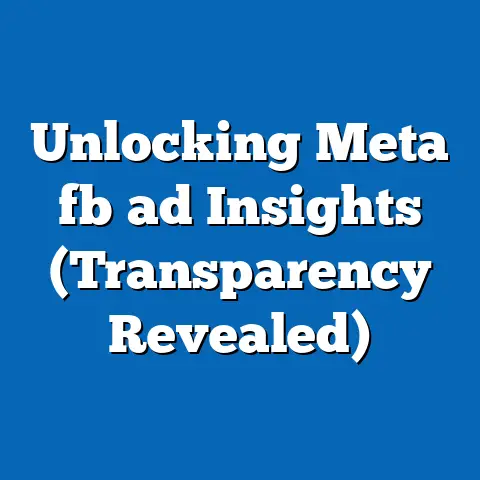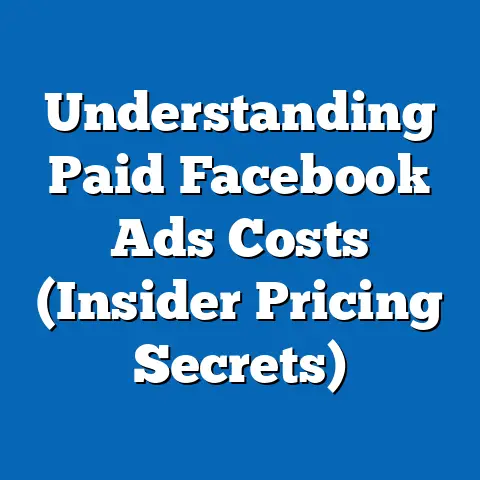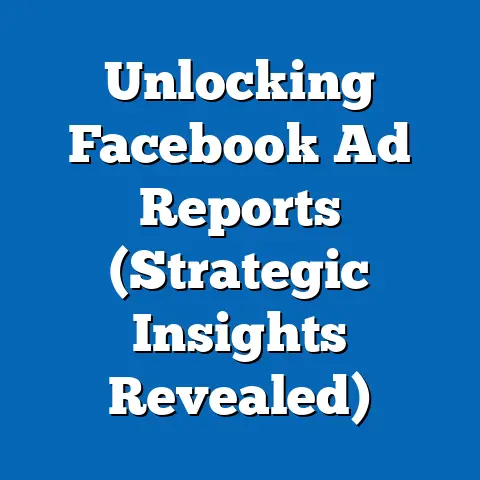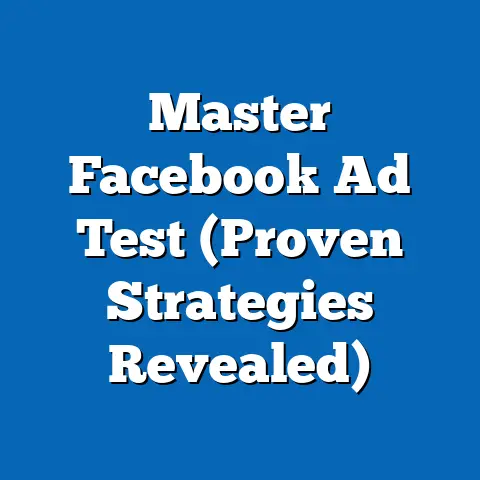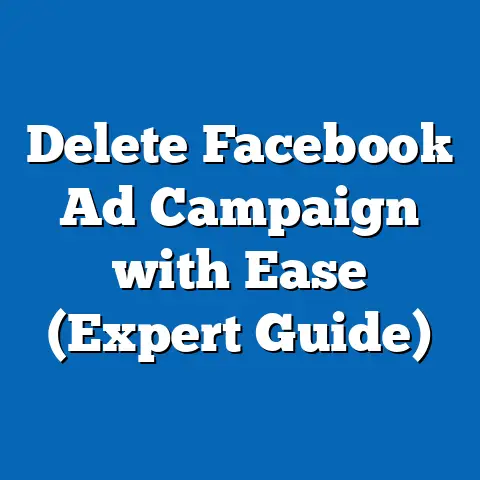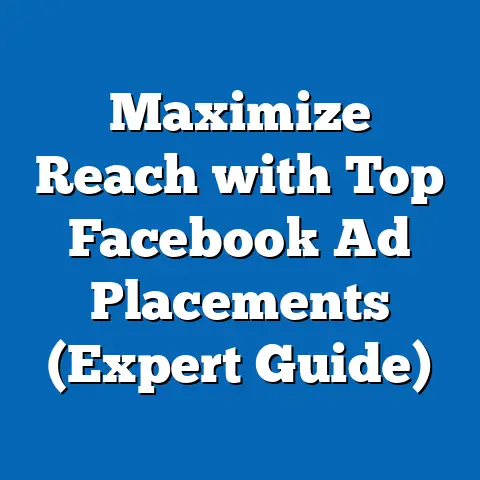Boost Engagement with Facebook Pop-Up Ads (Expert Strategies)
Have you ever felt like your Facebook ads were shouting into a void? I know I have. Early in my career, I was running a campaign for a local bookstore, pouring resources into beautifully designed ads that seemed to vanish into the newsfeed abyss. We were targeting book lovers, crafting witty copy, and still…crickets. Then, a mentor suggested we experiment with Facebook pop-up ads. Honestly, I was skeptical. Pop-ups felt intrusive, like relics of the early internet.
But, desperate to turn things around, we gave it a shot. We created a simple lead generation pop-up offering a discount on the next purchase in exchange for an email address. The results were astounding. Suddenly, we weren’t just throwing money at the algorithm; we were actively engaging with potential customers, building an email list, and driving in-store traffic. That experience completely changed my perspective on Facebook advertising.
Engagement isn’t just a buzzword; it’s the lifeblood of any successful digital marketing campaign. In today’s crowded online landscape, grabbing and holding attention is harder than ever. Facebook pop-up ads, when used strategically, can be a game-changer, transforming passive viewers into active participants. They can help you capture leads, promote special offers, remind users about events, and ultimately, drive conversions.
In this guide, I’ll walk you through the expert strategies I’ve learned over the years for maximizing engagement with Facebook pop-up ads. From understanding the psychology behind their effectiveness to crafting compelling content and targeting the right audience, I’ll cover everything you need to know to unlock your brand’s engagement potential on Facebook. Get ready to transform your approach to Facebook advertising and start seeing real results.
1. Understanding Facebook Pop-Up Ads
Let’s clear up any confusion. Facebook pop-up ads aren’t the same as those annoying, disruptive pop-ups that used to plague the internet. Instead, I’m referring to various ad formats that “pop up” within the Facebook or Instagram interface, often triggered by specific user actions or behaviors. They’re designed to be less intrusive and more relevant to the user’s experience.
Think of them as targeted interruptions that offer value.
Here are a few common formats:
- Lead Generation Forms: These pop-ups appear when a user clicks on a “Sign Up” or “Learn More” button within an ad. They allow you to collect user information, such as name, email address, and phone number, directly within Facebook, making it incredibly convenient for users to opt-in.
- Offer Claim Pop-Ups: These highlight special promotions, discounts, or freebies. They often appear after a user has engaged with your ad in some way, such as liking a post or watching a video. They create a sense of urgency and encourage immediate action.
- Event Reminder Pop-Ups: Perfect for promoting webinars, workshops, or online events. These pop-ups remind users who have expressed interest in the event to register or attend.
- Instant Experience Ads (formerly Canvas Ads): While not strictly pop-ups, these full-screen, mobile-optimized ads load instantly when a user clicks on an ad in their feed. They offer an immersive and engaging experience, allowing you to showcase your products or services in a visually compelling way.
So, what makes these formats so effective? It boils down to a few key psychological triggers:
- Urgency: Pop-ups often feature time-sensitive offers or limited-quantity promotions, creating a sense of urgency that compels users to act quickly.
- Exclusivity: Offering a special discount or bonus only to those who see the pop-up makes users feel valued and appreciated, increasing their likelihood of engaging.
- Personalization: Tailoring the pop-up message and offer to the user’s specific interests or behaviors makes it more relevant and engaging.
Think about it – if you see an ad for a product you’ve been eyeing, offering a limited-time discount, you’re much more likely to click on it than a generic ad. That’s the power of a well-crafted Facebook pop-up ad.
Takeaway: Facebook pop-up ads are strategic interruptions designed to offer value and drive engagement. Understanding the different formats available and the psychological triggers they leverage is crucial for creating effective campaigns.
2. The Importance of Engagement
In the world of digital marketing, engagement is king. It’s not enough to simply show your ads to a large audience; you need to capture their attention, spark their interest, and encourage them to interact with your brand. Engagement is the bridge that connects your advertising efforts to real business results.
Why is engagement so important? Let’s look at some statistics:
- Increased Brand Awareness: Engaged users are more likely to remember your brand and share your content with their friends and followers, expanding your reach organically.
- Higher Conversion Rates: Users who actively engage with your ads are more likely to click through to your website, make a purchase, or sign up for your email list.
- Improved Customer Loyalty: Engaging with your audience on a personal level fosters a sense of community and loyalty, leading to repeat business and positive word-of-mouth.
- Better Ad Performance: Facebook’s algorithm favors content that generates high engagement, rewarding engaging ads with better visibility and lower costs.
Think of it this way: every like, comment, share, and click is a vote of confidence in your brand. The more votes you receive, the higher your ad will rank in the newsfeed, and the more people will see it.
In fact, studies have shown that ads with high engagement rates can achieve up to 50% lower cost-per-click and 20% higher conversion rates compared to ads with low engagement. That’s a significant difference!
I remember working with a local coffee shop that was struggling to compete with the big chains. Their Facebook ads were getting impressions, but no one was engaging with them. We decided to focus on creating more engaging content, such as behind-the-scenes videos, interactive polls, and contests. We also started using Facebook pop-up ads to promote special offers and events.
The results were incredible. Within a few months, their engagement rates skyrocketed, their website traffic doubled, and their in-store sales increased by 30%. They were able to build a loyal following of customers who felt connected to their brand.
Takeaway: Engagement is essential for the success of your Facebook advertising campaigns. It drives brand awareness, increases conversion rates, improves customer loyalty, and boosts ad performance.
3. Crafting Compelling Pop-Up Ads
Creating a Facebook pop-up ad that actually captures attention and drives engagement is an art and a science. It requires a deep understanding of your target audience, a knack for persuasive writing, and an eye for visually appealing design.
Here are the key components of an effective pop-up ad:
-
Attention-Grabbing Headline: Your headline is the first (and often only) thing people will see, so it needs to be compelling and relevant. Use strong verbs, intriguing questions, and benefit-driven language to pique their interest.
- Instead of: “Sign Up for Our Newsletter”
- Try: “Unlock Exclusive Discounts and Expert Tips!”
-
Persuasive Copy: Once you’ve grabbed their attention, you need to convince them to take action. Highlight the benefits of your offer, explain why it’s valuable, and create a sense of urgency. Keep it concise and easy to understand.
-
Focus on what the user will gain by engaging with your ad.
- Use strong calls to action like “Shop Now,” “Download Now,” or “Get Started Today.”
-
Eye-Catching Visuals: A picture is worth a thousand words. Use high-quality images or videos that are relevant to your offer and visually appealing to your target audience.
-
Use bright colors, interesting compositions, and images that evoke emotion.
- Make sure your visuals are optimized for mobile devices.
-
Clear Call to Action (CTA): Tell people exactly what you want them to do. Use clear, concise, and action-oriented language.
-
“Shop Now”
- “Download Your Free Guide”
- “Sign Up for Your Free Trial”
-
Sense of Urgency: Create a sense of urgency by highlighting time-sensitive offers or limited-quantity promotions.
-
“Offer Ends Tonight!”
- “Limited Spots Available”
- “While Supplies Last”
Attention-Grabbing Headline: Your headline is the first (and often only) thing people will see, so it needs to be compelling and relevant. Use strong verbs, intriguing questions, and benefit-driven language to pique their interest.
- Instead of: “Sign Up for Our Newsletter”
- Try: “Unlock Exclusive Discounts and Expert Tips!”
-
Persuasive Copy: Once you’ve grabbed their attention, you need to convince them to take action. Highlight the benefits of your offer, explain why it’s valuable, and create a sense of urgency. Keep it concise and easy to understand.
-
Focus on what the user will gain by engaging with your ad.
- Use strong calls to action like “Shop Now,” “Download Now,” or “Get Started Today.”
-
Eye-Catching Visuals: A picture is worth a thousand words. Use high-quality images or videos that are relevant to your offer and visually appealing to your target audience.
-
Use bright colors, interesting compositions, and images that evoke emotion.
- Make sure your visuals are optimized for mobile devices.
-
Clear Call to Action (CTA): Tell people exactly what you want them to do. Use clear, concise, and action-oriented language.
-
“Shop Now”
- “Download Your Free Guide”
- “Sign Up for Your Free Trial”
-
Sense of Urgency: Create a sense of urgency by highlighting time-sensitive offers or limited-quantity promotions.
-
“Offer Ends Tonight!”
- “Limited Spots Available”
- “While Supplies Last”
Persuasive Copy: Once you’ve grabbed their attention, you need to convince them to take action. Highlight the benefits of your offer, explain why it’s valuable, and create a sense of urgency. Keep it concise and easy to understand.
Focus on what the user will gain by engaging with your ad.
Eye-Catching Visuals: A picture is worth a thousand words. Use high-quality images or videos that are relevant to your offer and visually appealing to your target audience.
Use bright colors, interesting compositions, and images that evoke emotion.
Clear Call to Action (CTA): Tell people exactly what you want them to do. Use clear, concise, and action-oriented language.
“Shop Now”
Sense of Urgency: Create a sense of urgency by highlighting time-sensitive offers or limited-quantity promotions.
“Offer Ends Tonight!”
But how do you know what will resonate with your audience? The answer is A/B testing. Experiment with different headlines, copy, visuals, and CTAs to see what works best. Facebook’s ad platform makes it easy to run A/B tests and track your results.
I always tell my clients to test everything, even seemingly small details. Sometimes, the simplest changes can have a big impact. For example, I once ran an A/B test on a Facebook pop-up ad for a local bakery. The only difference between the two ads was the color of the “Shop Now” button. One button was blue, and the other was red. The red button outperformed the blue button by 20%! It just goes to show that even the smallest details can make a difference.
Takeaway: Crafting compelling Facebook pop-up ads requires a combination of persuasive writing, visually appealing design, and a clear call to action. A/B testing is essential for optimizing your ads and maximizing engagement.
4. Targeting the Right Audience
Even the most beautifully crafted pop-up ad will fall flat if it’s not shown to the right people. Facebook’s powerful targeting capabilities allow you to reach a specific audience based on their demographics, interests, behaviors, and more.
Here are some key targeting strategies to consider:
-
Demographic Targeting: Target users based on age, gender, location, education, and other demographic factors.
- This is a great starting point for narrowing down your audience.
-
Interest-Based Targeting: Target users based on their interests, hobbies, and the pages they like on Facebook.
-
This allows you to reach people who are genuinely interested in your products or services.
-
Behavioral Targeting: Target users based on their online behavior, such as their purchase history, website activity, and mobile device usage.
-
This can be a powerful way to reach users who are likely to convert.
-
Custom Audiences: Create custom audiences by uploading your own customer data, such as email addresses or phone numbers.
-
This allows you to target your existing customers with special offers or promotions.
-
Lookalike Audiences: Create lookalike audiences based on your custom audiences. Facebook will identify users who share similar characteristics and behaviors to your existing customers.
-
This is a great way to expand your reach and find new customers.
Demographic Targeting: Target users based on age, gender, location, education, and other demographic factors.
- This is a great starting point for narrowing down your audience.
-
Interest-Based Targeting: Target users based on their interests, hobbies, and the pages they like on Facebook.
-
This allows you to reach people who are genuinely interested in your products or services.
-
Behavioral Targeting: Target users based on their online behavior, such as their purchase history, website activity, and mobile device usage.
-
This can be a powerful way to reach users who are likely to convert.
-
Custom Audiences: Create custom audiences by uploading your own customer data, such as email addresses or phone numbers.
-
This allows you to target your existing customers with special offers or promotions.
-
Lookalike Audiences: Create lookalike audiences based on your custom audiences. Facebook will identify users who share similar characteristics and behaviors to your existing customers.
-
This is a great way to expand your reach and find new customers.
Interest-Based Targeting: Target users based on their interests, hobbies, and the pages they like on Facebook.
This allows you to reach people who are genuinely interested in your products or services.
Behavioral Targeting: Target users based on their online behavior, such as their purchase history, website activity, and mobile device usage.
This can be a powerful way to reach users who are likely to convert.
Custom Audiences: Create custom audiences by uploading your own customer data, such as email addresses or phone numbers.
This allows you to target your existing customers with special offers or promotions.
Lookalike Audiences: Create lookalike audiences based on your custom audiences. Facebook will identify users who share similar characteristics and behaviors to your existing customers.
This is a great way to expand your reach and find new customers.
I’ve found that the most effective targeting strategies involve a combination of these methods. For example, you might start with demographic targeting to narrow down your audience, then use interest-based targeting to further refine it. You can then create a lookalike audience based on your existing customers to reach new people who are likely to be interested in your products or services.
Remember the bookstore I mentioned earlier? Initially, we were targeting anyone who had liked a book-related page on Facebook. But that was too broad. We refined our targeting to focus on people who had purchased books online, visited local bookstores, and attended literary events. This resulted in a much more engaged audience and a higher conversion rate.
Takeaway: Facebook’s targeting capabilities are essential for reaching the right audience with your pop-up ads. Experiment with different targeting strategies to find what works best for your business.
5. Timing and Frequency of Pop-Up Ads
Timing is everything. Showing your pop-up ads at the wrong time or too frequently can annoy users and damage your brand reputation. The goal is to strike a balance between capturing attention and providing a positive user experience.
Here are some guidelines to follow:
- Timely Triggers: Consider triggering your pop-up ads based on specific user actions or behaviors. For example, you might show a pop-up ad after a user has spent a certain amount of time on your website, viewed a specific product page, or added an item to their shopping cart.
- Data Analytics: Use data analytics to determine the best times to show your pop-up ads. Track your engagement rates and conversion rates at different times of day and days of the week.
- Frequency Caps: Set frequency caps to limit the number of times a user sees your pop-up ads. This will help prevent ad fatigue and ensure that your ads don’t become annoying.
- Rotating Messages: Rotate your pop-up ad messages and formats to keep things fresh and prevent users from getting tired of seeing the same ad over and over again.
- Exit-Intent Pop-Ups: Consider using exit-intent pop-ups, which are triggered when a user is about to leave your website. These can be a great way to capture leads or promote special offers before they leave.
I once worked with an e-commerce store that was showing pop-up ads to every visitor who landed on their website. The result was a high bounce rate and a lot of negative feedback. We decided to implement a more targeted approach, showing pop-up ads only to users who had spent at least 30 seconds on the site and viewed at least two product pages. We also set a frequency cap of one pop-up ad per user per day.
The results were dramatic. The bounce rate decreased significantly, and the conversion rate increased by 15%. By being more strategic about when and how often we showed pop-up ads, we were able to improve the user experience and drive better results.
Takeaway: Timing and frequency are crucial for maximizing engagement with Facebook pop-up ads. Use timely triggers, data analytics, frequency caps, and rotating messages to optimize your ad delivery.
6. Measuring Success and Optimization
You’ve crafted compelling pop-up ads, targeted the right audience, and optimized your timing and frequency. Now it’s time to measure your success and make adjustments based on your performance data.
Here are some key performance indicators (KPIs) to track:
- Click-Through Rate (CTR): The percentage of people who see your ad and click on it. This measures the effectiveness of your headline, copy, and visuals.
- Conversion Rate: The percentage of people who click on your ad and complete a desired action, such as making a purchase or signing up for your email list. This measures the effectiveness of your landing page and overall offer.
- Cost-Per-Click (CPC): The amount you pay each time someone clicks on your ad. This measures the efficiency of your ad campaign.
- Cost-Per-Acquisition (CPA): The amount you pay to acquire a new customer. This measures the overall ROI of your ad campaign.
- Engagement Metrics: Track likes, comments, shares, and other engagement metrics to gauge the level of interest in your ads.
Facebook Insights and other analytics tools can provide valuable data on your ad performance. Use this data to identify what’s working and what’s not, and make adjustments accordingly.
Here are some strategies for continuous optimization:
- A/B Testing: Continue to A/B test different elements of your pop-up ads, such as headlines, copy, visuals, and CTAs.
- Audience Refinement: Refine your targeting parameters based on your performance data. Identify which demographics, interests, and behaviors are driving the best results.
- Ad Placement Optimization: Experiment with different ad placements to see which ones are generating the most engagement.
- Landing Page Optimization: Make sure your landing page is optimized for conversions. Use clear headlines, persuasive copy, and a strong call to action.
Remember, optimization is an ongoing process. You should constantly be monitoring your performance data and making adjustments to improve your results.
Takeaway: Measuring success and optimization are essential for maximizing the ROI of your Facebook pop-up ads. Track your KPIs, analyze your data, and make adjustments based on your performance.
Conclusion
Facebook pop-up ads, when executed strategically, are a powerful tool for boosting engagement and driving real business results. By understanding the psychology behind their effectiveness, crafting compelling content, targeting the right audience, optimizing your timing and frequency, and continuously measuring your success, you can unlock your brand’s engagement potential on Facebook.
Don’t be afraid to experiment and try new things. The world of Facebook advertising is constantly evolving, so it’s important to stay up-to-date with the latest trends and best practices.
So, what are you waiting for? Start experimenting with Facebook pop-up ads today and see the transformative power they can have on your brand’s presence and customer interactions.
Call-to-Action
Want to learn more about maximizing your Facebook advertising ROI? Subscribe to my newsletter for expert insights, tips, and strategies. Share your experiences with Facebook pop-up ads in the comments below. I’d love to hear what’s working for you and what challenges you’re facing. And if you’re looking for personalized advice on enhancing your ad campaigns, don’t hesitate to reach out! Let’s work together to unlock your full potential on Facebook.

